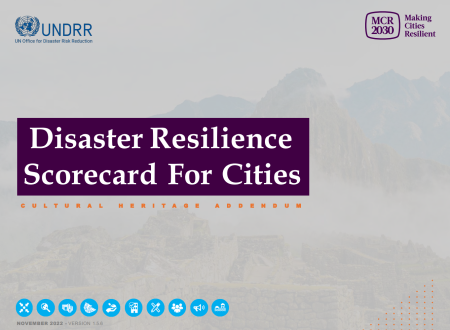Disaster Resilience Scorecard for Cities: cultural heritage addendum

“Cultural heritage (including tangible, intangible, and cultural industries) has a significant potential for reducing disaster risk and actively pursuing sustainable development. While the Sendai Framework for Disaster Risk Reduction 2015–2030 recognizes the importance of including cultural heritage into disaster risk reduction policies, there is still a gap in integrating cultural heritage into national and local disaster risk reduction strategies and vice-versa.
The Sendai Framework calls for integrating a cultural perspective in policies and practices by understanding the impacts on cultural heritage, in all its forms, when specific hazard events occur, and better-identifying risks possibly affecting cultural heritage before disasters occur. It calls for protecting cultural institutions and other historical, cultural heritage, and religious interest sites; engaging with local community cultural networks in managing disasters; and complementing scientific knowledge with traditional, indigenous, and local knowledge and practices in disaster risk assessment. This could be defined as the culture of resilience and the resilience of culture. We need to understand the impacts of risk on cultural heritage, identify those risks before a disaster occurs, and protect our cultural institutions and other sites of historical, cultural, and religious interest. To better protect lives, livelihoods, and cultural heritage is mandatory to strengthen people’s and assets’ resilience and make disaster risk reduction an intrinsic part of cultural heritage management. In a post-disaster situation, both tangible and intangible cultural heritage contribute to strengthening identity and social cohesion and inclusion; they operate actively in the recovery process of affected communities.
This Cultural Heritage Addendum to the Disaster Resilience Scorecard for Cities aims to support the development of culture-based and people-centered disaster risk reduction and resilience strategies integrated with cultural heritage and development policies.
The Disaster Resilience Scorecard for Cities (the ‘Scorecard’) is a tool designed to assist countries and local governments in monitoring and reviewing progress and challenges in implementing the Sendai Framework 2015-2030 at the local level. It is part of the Making Cities Resilient 2030 initiative, launched in 2020 by the United Nations Office for Disaster Risk Reduction (UNDRR) and its partners. This initiative aims to support cities worldwide, raise awareness of disaster resilience, highlight the economic impact of disasters and the need to invest in resilience, develop local disaster risk reduction strategies, and promote knowledge exchange among all concerned institutions, professionals, and citizens.” (p. 4-5)
